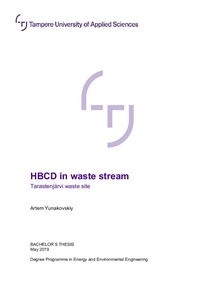HBCD in Waste Stream : Tarastenjarvi Waste Site
Yunakovskiy, Artem (2019)
Yunakovskiy, Artem
2019
Julkaisun pysyvä osoite on
https://urn.fi/URN:NBN:fi:amk-2019052913191
https://urn.fi/URN:NBN:fi:amk-2019052913191
Tiivistelmä
Hexabromocyclododecane (HBCD) has been classified as a persistent organic pollutant and subsequently banned from production and use by the Stockholm convention in 2013. HBCD has been widely used in insulation materials such as expanded and extruded polystyrene to increase their fire-retardant properties.
It is important that hexabromocyclododecane could be detected to ensure that a proper disposal method for polystyrene waste material is utilised.
The purpose of this study was to collect statistical data on the presence of HBCD in different polystyrene waste material in a waste stream of Tarastenjärvi waste site. The work was commissioned by Tampere University of Applied Sciences.
The analysis was divided into on-site screening of polystyrene samples of different types with a handheld x-ray fluorescence gun and acetone extraction with subsequent x-ray fluorescence measurements in laboratory conditions.
Out of 150 samples screened on-site, two expanded polystyrene samples of white colour were detected to contain hexabromocyclododecane and therefore possess the risk of exposure unless disposed in the correct way by incineration.
The collected data, the methods used as well as the equipment could be utilised by construction and waste management companies, or any other interested parties, for research purposes or as a detection method for HBCD in order to determine correct method of disposal for different polystyrene waste material.
It is important that hexabromocyclododecane could be detected to ensure that a proper disposal method for polystyrene waste material is utilised.
The purpose of this study was to collect statistical data on the presence of HBCD in different polystyrene waste material in a waste stream of Tarastenjärvi waste site. The work was commissioned by Tampere University of Applied Sciences.
The analysis was divided into on-site screening of polystyrene samples of different types with a handheld x-ray fluorescence gun and acetone extraction with subsequent x-ray fluorescence measurements in laboratory conditions.
Out of 150 samples screened on-site, two expanded polystyrene samples of white colour were detected to contain hexabromocyclododecane and therefore possess the risk of exposure unless disposed in the correct way by incineration.
The collected data, the methods used as well as the equipment could be utilised by construction and waste management companies, or any other interested parties, for research purposes or as a detection method for HBCD in order to determine correct method of disposal for different polystyrene waste material.
